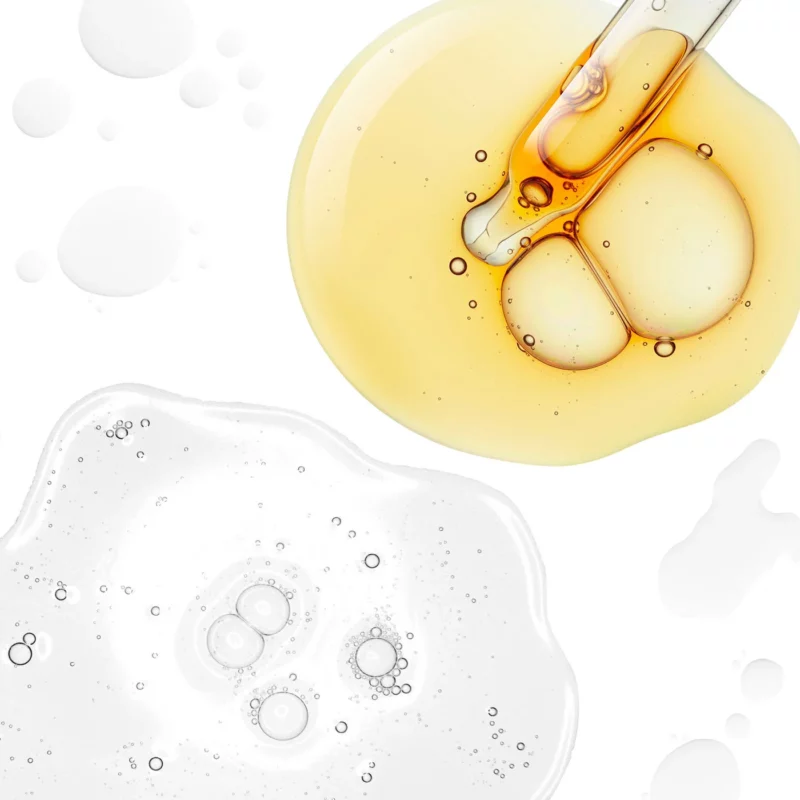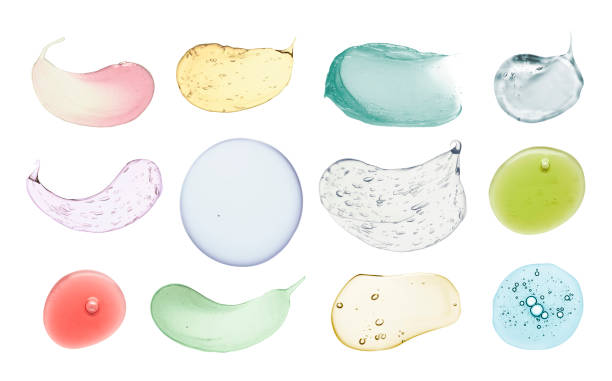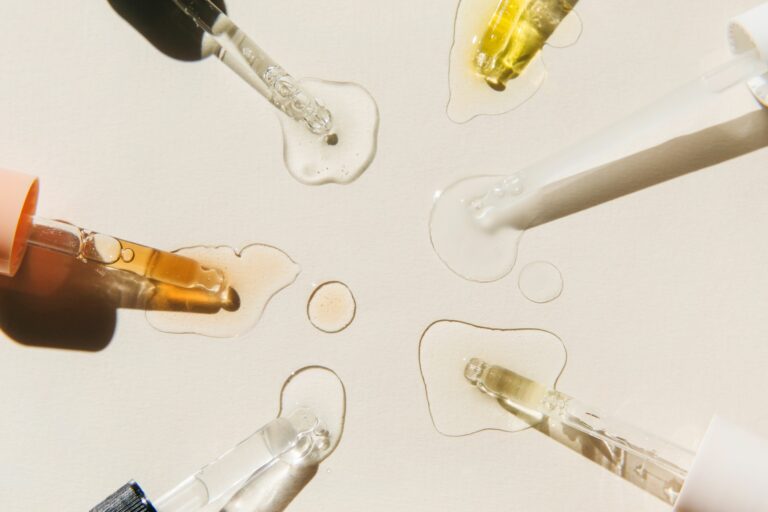Answering All Your Questions About Glycolic Acid And Retinol

WHAT ARE GLYCOLIC ACID AND RETINOL?
Glycolic acid and retinol are both skincare products. Glycolic acid is an AHA, or alpha hydroxy acid. An AHA is simply an animal- or plant-derived acid that can be used as ingredients in products for skincare. Other AHAs you may have heard of include lactic acid and citric acid. The term acid can sound kind of scary when it comes to skincare. But glycolic acid has a lot of research that demonstrates its safety and benefits for overall skin health.
Glycolic acid is derived from a plant called sugar cane. Its primary use is exfoliation. If you start using glycolic acid, some skin peeling might occur. This is because the acid is going to work and jumpstarting the exfoliation process. See, your skin is made up of multiple layers. Sometimes, the outermost layer gets its pores plugged up from oil or dead skin cells that haven’t sloughed off yet. The glycolic acid will cause the outer layer (and all the pore-plugging stuff on it) to peel away from the rest of your skin. This method of exfoliating is called chemical exfoliation.
You may have heard of retinols or retinoids before. The retinoid vs retinol debate can be confusing, but retinol is actually a type of retinoid. Unlike glycolic acid, retinol can be made from animal products, plant products, and even synthetic products. Retinol is also an exfoliant. It can take a bit longer to see results from retinol, but it’s quite the investment in your skin health. It works on a cellular level to promote collagen growth and cell turnover. Vegan retinol owes its effectiveness to Vitamin A-rich plants. Through the use of purely natural ingredients, vegan retinol like Plant Mother’s vegan retinol serum, rejuvenates the skin without irritating it. Avoid using retinol if pregnant or nursing.
DO GLYCOLIC ACID AND RETINOL GO TOGETHER?
If glycolic acid and retinol both improve skin appearance, do you really need both? Well, let’s talk about it. Both products work great on their own. However, glycolic acid and retinol work quite differently and achieve different results. Additionally, there is evidence to suggest that using both could help combat acne scarring. Research on the combo found that using both glycolic acid and retinol could be a treatment for acne scars. The results were pretty astounding. One study that tried the combination reported that glycolic acid and retinol helped with scars from pitted acne in a whopping 91% of participants.
Keep in mind that a combination approach does not actually involve physically combining glycolic acid and retinol. Please don’t use them both at the same time! This could cause your skin to become very dry or irritated. Most recommend adding in glycolic acid and retinol into your skincare routine very slowly.
Best Way To Introduce These Ingredients Into Your Skincare Routine
Start with the retinol. You’ll want to get your skin acclimated to the product. Try the retinol once a week for the first few weeks and observe. Once you feel ready, you can add 1-2 additional days of retinol use to your weekly routine. At most, use the retinol every other day. However, this doesn’t apply to vegan retinol, which is not going to cause any redness so you don’t need to introduce it gradually.
Once retinol is firmly established in your routine, try the glycolic acid. Don’t try it on a day that you apply retinol, however. Repeat the incremental introduction with glycolic acid, upping it to every other day (at the maximum.) If your skin seems to be handling it extraordinarily well, you might be able to apply one of the products in the morning and one at night. Although, alternating days is the preferred method. Also–don’t mix glycolic acid with another AHA, either. You don’t want a negative reaction on your skin!
WHAT ELSE SHOULD BE IN MY SKINCARE ROUTINE?
If you’re a man, we’ve got the article for you. The men’s skincare routine blog article will give you all the tips and tricks for developing the perfect routine. If not, we’ve still got you covered!
The best skincare products will be the ones that work best for your skin type. Conduct some research to determine what skin type you have, and which products work best for it. Start with a cleanser to wash your face thoroughly and remove dirt and dead skin cells from its surface. Glycolic acid will exfoliate your skin. Then, a toner rounds out the cleansing process and hydrates the skin. Some natural toner ingredients are rose water, aloe vera, and witch hazel.
Next would be a face serum like Plant Mother retinol or vitamin C serum. It’s best to use retinol as part of your evening routine, as opposed to your morning routine. Plant Mother’s Vitamin C serum is organic, plant-based, and highly effective. All serum ingredients are farmed ethically and without the use of pesticides or GMOs. Both face serums are packed with antioxidants and plants with anti-aging properties. The next step would be sunscreen.
Next time you run out of sunscreen, consider buying biodegradable sunscreen. It protects your skin from UV rays and protects our coral reefs simultaneously. Biodegradable sunscreen is composed of ingredients that decompose naturally and won’t bleach or otherwise damage coral reefs. When shopping for sunscreen, always check the ingredients list. Avoid buying products that include the ingredients oxybenzone and octinoxate. These are known to be toxic to corals and ocean life. Look for labels like biodegradable, reef-friendly, or reef-safe. Sunscreen products with this label shouldn’t have either toxic ingredient.

WHY HAVE I BEEN TOLD THAT I CAN’T COMBINE GLYCOLIC ACID AND RETINOL?
You might have been warned to never, under any circumstances, add both glycolic acid and retinol into your skincare routine. The practice used to be seen as a foolhardy and costly decision. It was believed that the different pH levels in glycolic acid and retinol canceled each other out, making both products functionally useless. However, retinol isn’t actually as fickle as many expected. Our skin’s natural pH level is acidic, after all. So, while retinol might do its best work at a more basic pH level, it can still work well in acidic conditions.
As for the irritation concerns, that’s why we recommend an extremely gradual approach. Introducing the products one at a time, slowly, is the best way to observe changes in your skin and hopefully prevent any potential dryness or irritation. And, again, avoid using them both in one sitting.
WHAT ARE THE BENEFITS OF USING GLYCOLIC ACID AND RETINOL?
There are plenty of benefits to using glycolic acid and retinol that we haven’t gotten to mention yet. The glycolic acid will exfoliate your skin and give it a smoother texture. The combination can help fight hyperpigmentation, too. The retinol is the perfect antidote to aging. It works to smooth fine lines, even out skin tone, prevent acne breakouts, and help reverse sun damage. The pair should help combat acne scarring and acne. The key is smooth and nourished skin. Together, glycolic acid and retinol can accomplish that.
WHY IS PLANT MOTHER’S RETINOL BETTER THAN TRADITIONAL RETINOLS?
While you have a lot of options when it comes to retinol, Plant Mother’s organic and plant-based vegan retinol is recommended. It’s the best vegan face serum on the market. Users of traditional retinols can experience sun sensitivity, skin irritation, redness, and dryness. On the other hand, Plant Mother’s retinol is far gentler and created with zero chemicals. You can achieve the same great results without the negative side effects through the use of natural ingredients like bakuchiol, maracuja, and acai.

CAN I USE GLYCOLIC ACID AND RETINOL IF I HAVE SENSITIVE SKIN?
Yes, if you choose to use plant-based products formulated for sensitive skin, such as Plant Mother’s retinol serum. If you choose to use synthetic products, you can probably still use these products if you have sensitive skin but proceed with caution. Introduce the products at an even more gradual pace. If the sensitivity is extreme, you could ask a dermatologist first to see what they think about this approach. They may help you create a manageable routine with this combo, or they can guide you toward a gentler approach that will work better for your skin type. If you start this method and have a severe negative response, stop immediately and see a doctor or dermatologist. Some peeling is common but trust your gut and get medical help if your body reacts negatively.
ARE GLYCOLIC ACID AND RETINOL NATURAL?
Glycolic acid is completely natural. Natural skincare products improve skin health without harsh or toxic ingredients like chemicals.
It comes from the much beloved plant sugar cane. Retinol can be made naturally or synthetically. Always be sure to check the label and research the skincare brand when shopping. This will let you know if the retinol you’re considering is plant-derived, animal-derived, or synthetic. All Plant Mother products are plant-based and organic.
WHAT ARE THE SIDE EFFECTS OF GLYCOLIC ACID AND RETINOL?
Side effects of glycolic acid and retinol include redness, hyperpigmentation, peeling/flaking, itchiness, and sun sensitivity. Hyperpigmentation is a big word for developing darker marks. Sun sensitivity is a little self-explanatory, but it just means that you have a higher likelihood of getting a sunburn. That means it’s extra important to apply sunscreen every morning and apply it again every hour and a half.
Using retinol can also, on rare occasions, cause acne breakouts or swelling. If you experience a side effect, you’ll want to decrease the frequency of product use or discontinue use altogether until you can see a dermatologist.
CONCLUSION
The myth that warns against using glycolic acid and retinol has been debunked! It’s not just safe to use a combination approach—it can also be more effective than using just one or the other. The duo can even improve acne scarring. Be sure to do some research to find the best individual products for you, introduce each product slowly one at a time, and never be afraid to reach out to your dermatologist if you observe a side effect that concerns you.
Also, remember that vegan retinol is gentler than conventional retinols. And always, always wear sunscreen. Even if you’re planning to wear a hat. Even if it’s cloudy. And even if you’ll spend most of your time indoors. Applying sunscreen is low-effort, and the sun protection is vital.
If you’re on the hunt for new skincare products, remember that you’re voting with your dollars. Look up the brand you’re considering. Do they test their products on animals? Do they use zero-waste, non-plastic packaging? Now, more than ever, we as individual citizens have the power to hold businesses responsible. Support businesses that care for the environment we all share, instead of polluting it. They’re out there, we promise. We wish you the best of luck on your skincare journey!
MEDICAL DISCLAIMER
This content is for informational and educational purposes only. It is not intended to provide medical advice or to take the place of such advice or treatment from a personal physician. All readers of this content are advised to consult their doctors or qualified health professionals regarding specific health questions. The publisher of this content does not take responsibility for possible health consequences of any person or persons reading or following the information in this educational content. All viewers of this content, especially those taking prescription or over-the-counter medications, should consult their physicians before beginning any nutrition, supplement, skincare product, or lifestyle program.
